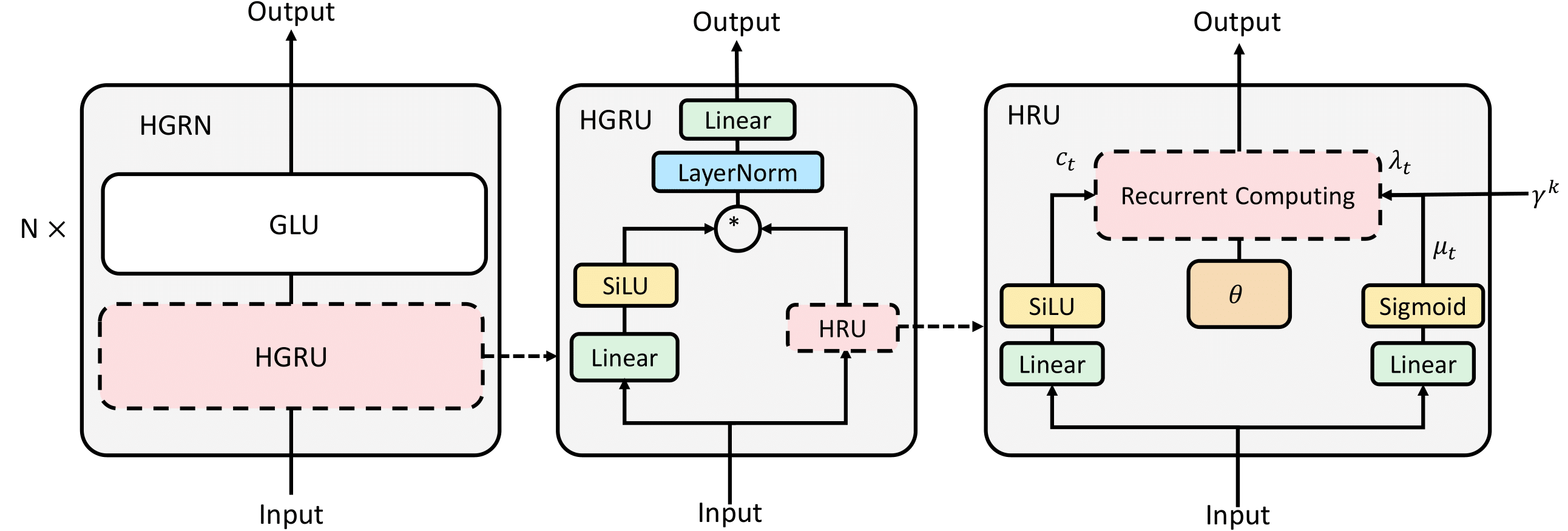HGRN - Hierarchically Gated Recurrent Neural Network for Sequence Modeling
💻 GitHub
Overall Architecture
The overall network architecture is as follows:

Experiments
Environment Preparation
Our experiment uses two conda environments, where Autoregressive language modeling, needs to configure the environment according to the Env1 part, and LRA needs to configure the environment according to the Env2 part.
Env1
First build the conda environment based on the yaml file:
conda env create --file env1.yaml
If you meet an error when installing torch, just remove torch and torchvision in the yaml file, rerun the above command, and then run the below commands:
conda activate hgrn
wget https://download.pytorch.org/whl/cu111/torch-1.8.1%2Bcu111-cp36-cp36m-linux_x86_64.whl
pip install torch-1.8.1+cu111-cp36-cp36m-linux_x86_64.whl
pip install -r requirements_hgrn.txt
Then, install hgru-pytorch:
conda activate hgrn
cd hgru-pytorch
pip install .
Finally, install our version of fairseq:
cd fairseq
pip install --editable ./
Env2
Build the conda environment based on the yaml file:
conda env create --file env2.yaml
If you encounter difficulties in setting up the environment, you can install the conda environment first, and then use the following command to install the pip packages:
pip install torch==1.10.0+cu111 torchvision==0.11.1+cu111 -f https://download.pytorch.org/whl/torch_stable.html
pip install -r requirements_lra.txt
Finally, install hgru-pytorch:
conda activate lra
cd hgru-pytorch
pip install .
Autoregressive language model
1) Preprocess the data
First download the WikiText-103 dataset:
wget https://s3.amazonaws.com/research.metamind.io/wikitext/wikitext-103-raw-v1.zip
unzip wikitext-103-raw-v1.zip
Next, encode it with the GPT-2 BPE:
mkdir -p gpt2_bpe
wget -O gpt2_bpe/encoder.json https://dl.fbaipublicfiles.com/fairseq/gpt2_bpe/encoder.json
wget -O gpt2_bpe/vocab.bpe https://dl.fbaipublicfiles.com/fairseq/gpt2_bpe/vocab.bpe
for SPLIT in train valid test; do \
python -m examples.roberta.multiprocessing_bpe_encoder \
--encoder-json gpt2_bpe/encoder.json \
--vocab-bpe gpt2_bpe/vocab.bpe \
--inputs wikitext-103-raw/wiki.${SPLIT}.raw \
--outputs wikitext-103-raw/wiki.${SPLIT}.bpe \
--keep-empty \
--workers 60; \
done
Finally, preprocess/binarize the data using the GPT-2 fairseq dictionary:
wget -O gpt2_bpe/dict.txt https://dl.fbaipublicfiles.com/fairseq/gpt2_bpe/dict.txt
fairseq-preprocess \
--only-source \
--srcdict gpt2_bpe/dict.txt \
--trainpref wikitext-103-raw/wiki.train.bpe \
--validpref wikitext-103-raw/wiki.valid.bpe \
--testpref wikitext-103-raw/wiki.test.bpe \
--destdir data-bin/wikitext-103 \
--workers 60
This step comes from fairseq.
2) Train the autoregressive language model
Use the following command to train language model:
bash script_alm.sh
You should change data_dir to preprocessed data.
Image modeling
bash script_im.sh
LRA
1) Preparation
Download the codebase:
git clone https://github.com/OpenNLPLab/lra.git
Download the data:
wget https://storage.googleapis.com/long-range-arena/lra_release.gz
mv lra_release.gz lra_release.tar.gz
tar -xvf lra_release.tar.gz
2) Training
Use the following script to run the experiments, you should change PREFIX to your lra path, change tasks to a specific task:
python script_lra.py
Standalone code
See hgru-pytorch.
- Downloads last month
- 17